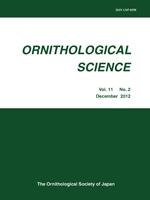Although Narcissus Flycatchers readily use nest boxes, natural nest sites and nest characteristics have not previously been described. The location of 41 Narcissus Flycatcher nests and data on the dimensions of 17 nest holes in the Fuji Primitive Forest of Japan are described. Japanese Hemlocks were the most commonly chosen tree species for nesting although 14 other tree species were also used and no significant nest tree species preference was observed. Nests (classified as either half cavity, full cavity, chimney, or shelf), were built at an average height of 7.3 m. Flycatchers tended to nest in dead trees or trees with trunks greater than 20 cm in diameter (mean 30.9 cm). Nests were typically made from dead leaves, moss, plant fibers, and animal hair. This is the first description of natural nest sites and nest characteristics of Narcissus Flycatchers; details are compared with those of other closely related flycatcher species.
How to translate text using browser tools
1 December 2012
The Nest Sites and Nest Characteristics of Narcissus Flycatcher Ficedula narcissina
Yuji Okahisa,
Gen Morimoto,
Kentaro Takagi
ACCESS THE FULL ARTICLE

Ornithological Science
Vol. 11 • No. 2
December 2012
Vol. 11 • No. 2
December 2012
Ficedula narcissina
Hole dimensions
Natural holes
nest sites
Primitive forest




